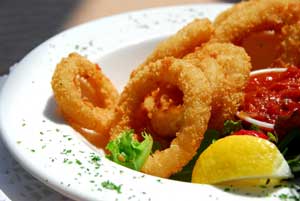Calamari
 |
Calamari (Italian for squid) are delicious cooked in a variety of ways, including fried rings. The body, tentacles, and even the ink pouch are used. |
The body (called mantle, hood, or tube), tentacles, and fins are all edible. Even the inky liquid used as a defense mechanism is collected for coloring sauces, pasta, and rice. The body can be stuffed or sliced into rings. Fins can be sliced or chopped for salads. Tentacles – with and without the suction cups – are also a delicacy. Larger calamari are tenderized and cut into fillets.
A wide range of ethnic dishes include calamari, such as Yum Pra-Hmik (Thai Squid Salad). They are also served in many Japanese sushi restaurants.
Varieties
Common species include the squid, the long-finned winter squid, the short-finned summer squid, ’s arrow squid, and the giant squid.
Buying Tips
The membrane of fresh, unskinned squid should be gray and the body firm with a gloss. Skinned and cleaned calamari will save time, but also cost more.
Storage Tips
Clean and place in a pan, cover with a damp towel and keep refrigerated. Prepare within twenty-four hours. After cooking, refrigerate up to three days.
Calamari freezes well and may make the meat less chewy. Consume within two months.
Usage Tips
• To reduce rubbery texture, tenderize fillets with a mallet.
• Braising (for about one hour) breaks down some of the fibrous muscle. Otherwise, calamari should be cooked very briefly over high heat.
• If purchasing squid whole, they must be cleaned first. By pulling the head away from the hood (mantle), most of the insides will follow. Be sure to remove the inner backbone (quill), which looks like a long strip of plastic. The membrane can be rubbed off. Separate the wings from the mantle and the tentacles from the eyes. Squeeze out the beak.
• After cleaning, cut according to desired cooking method, place in a bowl of cold water or buttermilk for 1-2 hours, then drain.
• If grilling both mantle and tentacles, skewer them separately as the legs require a bit longer cooking time.
• Breaded and fried rings (from the mantle) are most popular and served in numerous ways. Try them plain with a side of sauce, dipped into fondue, or over noodles, rice, or polenta.





